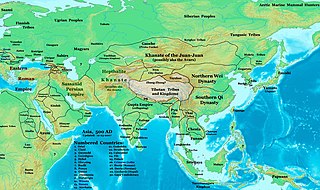 W
WThe Chen dynasty, also known as the Southern Chen, was the fourth and last of the Southern Dynasties in China. Following the Liang dynasty, the Chen dynasty was founded by Chen Baxian. The Chen dynasty further strengthened and revitalized the economy and culture of Southern China, and even made territorial expansions northward, laying the foundation for future dynasties. It was succeeded by the Sui dynasty, a short-lived dynasty that was then destroyed by the Tang dynasty. The Chen royal family continued to hold powerful high-ranking positions in both the Sui and Tang governments.
 W
WThe Liang dynasty (502–557), also known as the Southern Liang, was the third of the Southern Dynasties during China's Southern and Northern Dynasties period. It was located in South China and succeeded by the Chen dynasty in 557. The small rump state Western Liang (555–587), located in Central China, continued until it was destroyed in 587 by the Sui dynasty.
 W
WThe Liang (555–587), known in historiography as the Western Liang (西梁) or the Later Liang (後梁) to distinguish it from the earlier Liang dynasty (502–557), was a small puppet state during the Northern and Southern dynasties period, located in the middle Yangtze region in today's central Hubei province. From 555 to 557 it was subservient to the Western Wei, from 557 to 581 to the Northern Zhou, and from 581 to 587 to the Sui dynasty before the Sui annexed it.
 W
WThe military history of the Northern and Southern dynasties encompasses the period of Chinese military activity from 420 to 589. Officially starting with Liu Yu's usurpation of the Jin throne and creation of his Liu Song dynasty in 420, it ended in 589 with the Sui dynasty's conquest of Chen dynasty and reunification of China. The first of the Northern dynasties did not however begin in 420, but in 386 with the creation of Northern Wei. Thus there is some unofficial overlap with the era of the Sixteen Kingdoms.
 W
WThe Northern and Southern dynasties was a period in the history of China that lasted from 420 to 589, following the tumultuous era of the Sixteen Kingdoms and the Wu Hu states. It is sometimes considered as the latter part of a longer period known as the Six Dynasties. Though an age of civil war and political chaos, it was also a time of flourishing arts and culture, advancement in technology, and the spread of Mahayana Buddhism and Daoism. The period saw large-scale migration of Han Chinese to the lands south of the Yangtze. The period came to an end with the unification of all of China proper by Emperor Wen of the Sui dynasty.
 W
WThe Northern Qi, also called Later Qi and Gao Qi, was one of the Northern dynasties of imperial China history and ruled northeastern China from 550 to 577. The dynasty was founded by Emperor Wenxuan, and it was ended following attacks from Northern Zhou.
 W
WThe Southern Qi (479–502) also known as Xiao Qi(simplified Chinese: 萧齐; traditional Chinese: 萧齊; pinyin: Xiāo Qí) was the second of the Southern dynasties in China, followed by the Liang Dynasty.
 W
WThe Eastern Wei followed the disintegration of the Northern Wei, and ruled northern China from 534 to 550. As with Northern Wei, the ruling family of Eastern Wei were members of the Tuoba clan of the Xianbei.
 W
WThe Northern Wei, also known as the Tuoba Wei (拓跋魏), Later Wei (後魏), was a dynasty founded by the Tuoba (Tabgach) clan of the Xianbei, which ruled northern China from 386 to 534 AD, during the period of the Northern and Southern Dynasties. Described as "part of an era of political turbulence and intense social and cultural change", the Northern Wei Dynasty is particularly noted for unifying northern China in 439: this was also a period of introduced foreign ideas, such as Buddhism, which became firmly established. The Northern Wei were referred to as "Plaited Barbarians" by writers of the Southern dynasties, who considered themselves the true upholders of Chinese culture.
 W
WThe Western Wei followed the disintegration of the Northern Wei, and ruled northern China from 535 to 557. As with the Northern Wei state that preceded it, the ruling family of Western Wei were members of the Tuoba clan of the Xianbei.
 W
WThe Northern Zhou followed the Western Wei, and ruled northern China from 557 to 581 AD. The last of the Northern Dynasties of China's Northern and Southern dynasties period, it was eventually overthrown by the Sui Dynasty. Like the preceding Western and Northern Wei dynasties, the Northern Zhou emperors were of Xianbei descent.